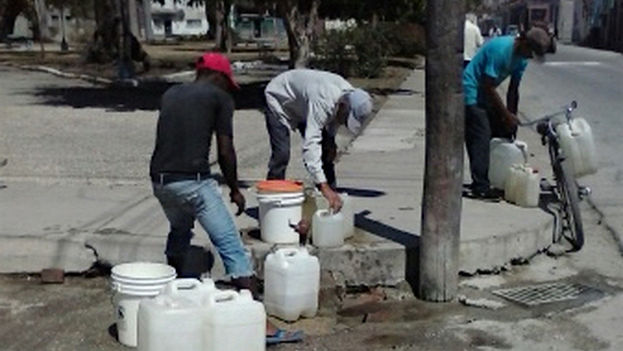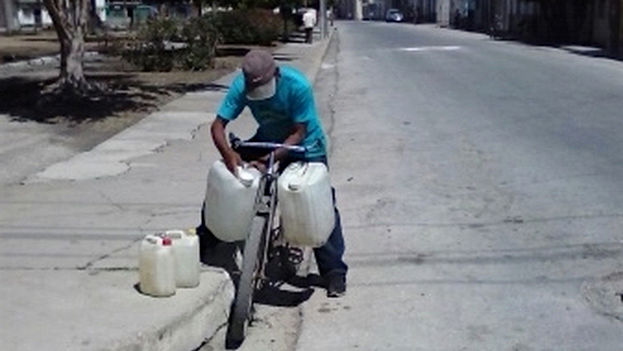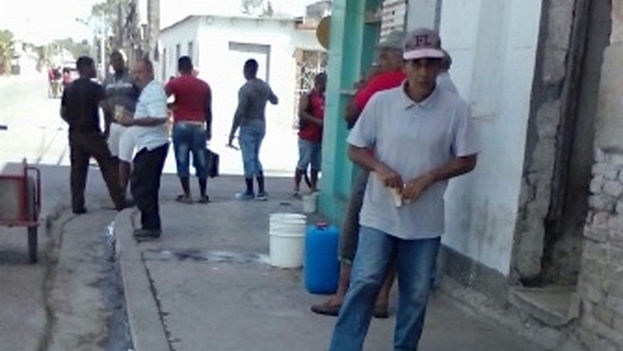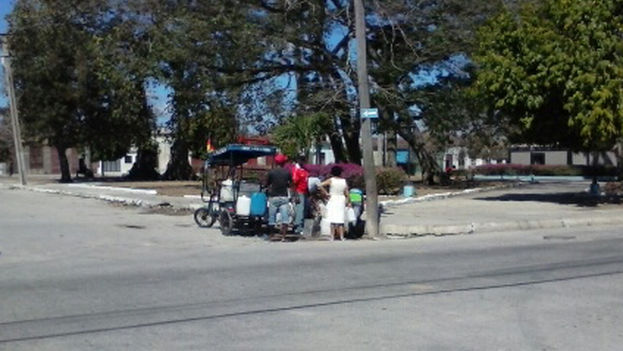
![]() 14ymedio, Luz Escobar, Havana, 30 March 2017 — Through the streets of Sagua la Grande, in the province of Villa Clara, people walk around with bottles, buckets and every kind of receptacle. This month’s break in the turbine that supplies the city’s water has forced its inhabitants to carry water from different towns.
14ymedio, Luz Escobar, Havana, 30 March 2017 — Through the streets of Sagua la Grande, in the province of Villa Clara, people walk around with bottles, buckets and every kind of receptacle. This month’s break in the turbine that supplies the city’s water has forced its inhabitants to carry water from different towns.
“It’s been more than a week without water,” Jaime Guillermo Castillo, a resident, told 14ymedio. “We fill the buckets at some public taps very far from the center, everyone goes to the closest one however they can. We go in horse-drawn carts, on bicycles, or whatever appears.”
The municipality is supplied by a public aqueduct system that has three basic sources: Caguaguas about 7 miles away, Chincilla about 6 miles, and Viana, nearly 10 miles. But with the acute drought affecting the whole country, the first of these sources has had to come up with most of the supply.

The breaking of the Caguaguas turbine aggravated the situation. The equipment was taken to Santa Clara for repairs but the residents complain about the lack of information and the excessive delay. The problem has reached the point that several residents have called the local People’s Power delegate to resolve the problem as soon as possible or to make a public protest.
“First they said it was only for a couple of days, but we have been dealing with this for more than a week and the situation is getting worse,” laments farmer Jorge Pablo, who fears “big crop losses” because it’s been at least eight days without being able to put “a single drop of water in the furrows.”
According to the Population and Housing Census of 2012, the municipality Sagua la Grande has about 52,334 inhabitants, 90% in urban areas. Problems with water supply have been frequent in recent years due to poor infrastructure.
Several areas of the city have also had problems with water pressure for decades, mainly in the San Juan neighborhood, the southern part of Victoria Center and Loma Bonita. Water is almost entirely unavailable in the latter. A situation that has forced many villagers to drill wells for their homes, which has brought a deterioration of the water table.

A study a decade ago calculated that water losses in the city were estimated at 30% and were mainly caused by leaks and uncontrolled consumption. Of the total water that is pumped from the sources of supply, about 410 liters per second, only about 290 reach the city.
Instead of improving, the situation has continued to worsen in the last ten years and the people’s council areas with the greatest difficulties are Coco Solo and Centro Victoria.
The driver from Caguaguas has also suffered the problems of maintenance and conservation, as well as the shortage of equipment and qualified personnel to maintain a stable service, according to local press reports.
Authorities attribute part of these problems to “unscrupulous citizens” who drill holes in the water distribution pipes to illicitly irrigate small orchards. The presence in the area of numerous producers of meat with clandestine farms has contributed to the increase of the phenomenon.

However, the residents point out that the promised investments have not been made to avoid the continuous breaks. “Nobody cares about this town,” laments Herminia, was was born there and who is now trying to sell her four-room property with an immense patio.
The Villaclareña puts her hopes on the sale of her house to leave what she considers has become “a place with no future.” She feels that Sagua la Grande has undergone a process of deterioration and “the frequent breakingof the turbine is another step in this fall.” Not even the 2011 declaration making the historic city center as a National Monument managed to stop the process.
“A town without water is a ghost town,” says Herminia. “Parents do not want to send children to school in dirty uniforms and older people are the ones who are worse off because they cannot carry water from afar.” She paid a water-bearer about 50 Cuban pesos (about $2 US), a quarter of her pension, to fill a tank that she only uses for cooking: “A bath is a luxury that I can not give myself,” she says resignedly.
